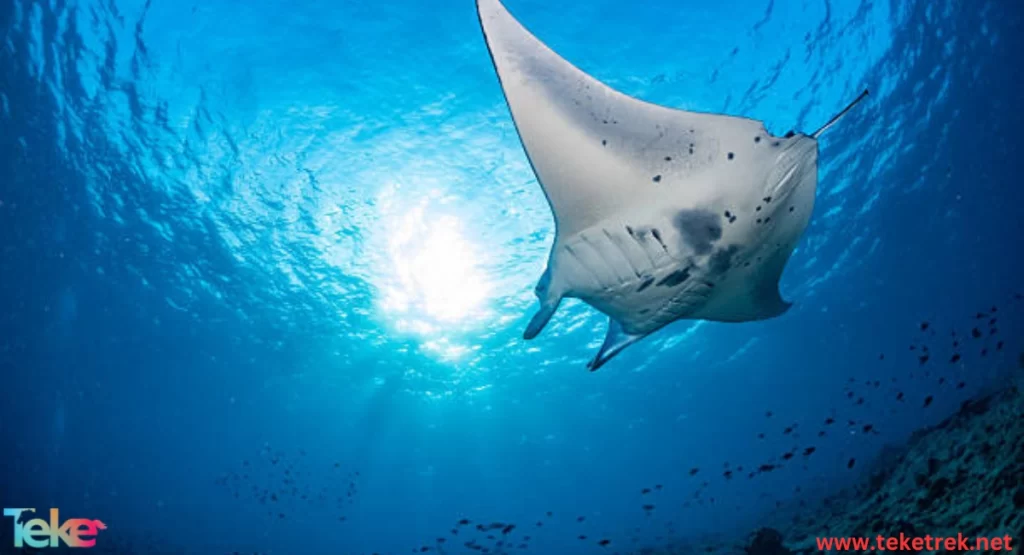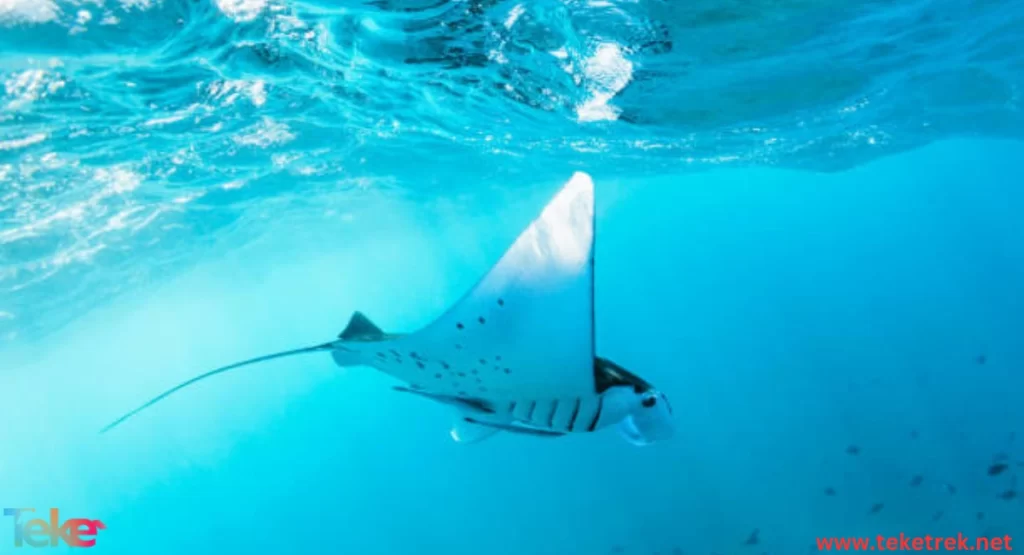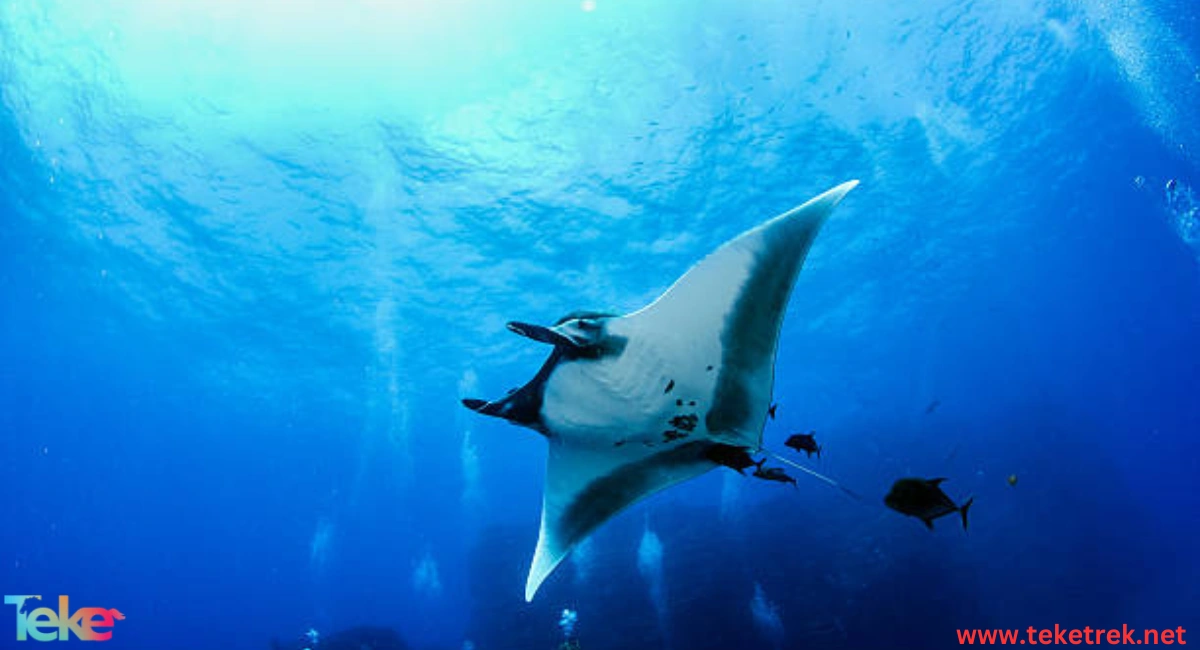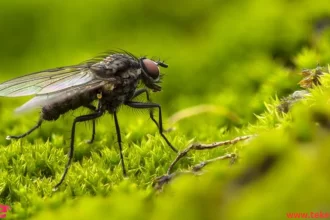It also known as the Devil fish, Giant Devil Ray, Manta Ray, is a type of eagle ray that is at risk of extinction.
It is widespread in both the Mediterranean Sea and the Atlantic Ocean.
Let’s learn more about it from teketrek.
Facts about The Devil Ray
The Manta Ray is known for its spiked tail that it uses to defend itself against predators.
They also have respiratory spiracles, eyes on the sides of their bodies, and gill slits on the abdomen.
The manta ray has conical protrusions and convex ridge-like ridges spread over the body, pelvis and tail, and on the sides of the back and ventral surface of the body. While the convex protrusions on the abdominal surface spread radially.
Interesting behaviors and facts about the Manta Ray include its lack of teeth except in the lower jaw, its ability to change color to blend with its surroundings for protection, and its acrobatic leaps out of the water creating a loud sound similar to a gunshot.
Climate change affecting plankton populations, which are a primary food source for Manta Rays, is a significant threat to their survival.
Overall, the Manta Ray is a gentle creature often referred to as the Devil Ray due to its dark appearance and horn-like cephalic fins.
The manta ray glides through the waves in alternating turns and dancing steps, spreading its huge fins that resemble broad, spread wings or the corners of a dark raincoat.
If a manta ray swallows the bait, it jumps away, then allows itself to hook behind a fishing boat that is running very fast.
The manta ray makes great leaps at lightning speed, then bounces back to the surface of the water. It then makes a pop when its fins come into contact with the water. This crackle is similar to the sound of a gun, and can be heard several kilometers away.

The Manta Rays specification
Tail:It can grow up to 5 meters in length.
Brain: has the largest brain of any fish in the world.
The length of each lobe of the brain from tip to mouth is about 14% of the total body size.
Fins: The Giant Manta Ray has pectoral fins that resemble wings, protruding forward at the front of the head. Manta Rays have vertical fins located at the front of the pectoral axis, with a height approximately 83% of their base length.
Mouth: It has a large, rectangular mouth with teeth only on the lower jaw. It has 18 rows of teeth in the middle of the lower jaw, with number of rows decreasing from 12 to 14 rows towards the sides of the mouth.
Color: The coloration of the Manta Ray is unique to each individual, generally ranging from brown or grayish-blue to black on the upper side, with pale tips and a white underside.
Some species of Manta Ray have pale spots and colorful patterns on top, and dark spots on the bottom.
Fascinating World of The Honey Bee: Nature’s Tiny Miracle Worker
Where are Manta Rays found?
Manta Rays are widespread in the Mediterranean Sea and the Atlantic Ocean. They can also be found off the southwestern coast of Ireland and southern Portugal, and possibly in the northwest Atlantic. Devil Rays often prefer to stay in deep waters.
Manta Rays inhabit coastal regions opposite continental shelves and live-in deep waters reaching depths of thousands of meters. Devil Rays are usually seen in small groups, sometimes forming larger groups.
What does the devil ray eat?
Manta Rays feed on various plankton and small fish. They filter feed on plankton using gill rakers, which are a series of tissue plates such as reddish sponge-like structures placed on consecutive gill bars that support the gill rakers. When feeding, their brain lobes open to direct plankton-rich water towards their mouths.
Other fish species have suction discs attached to their lower sides, consuming scales and aquatic plankton resulting from their food.
Reproductive stages of Manta Rays
Male Manta Rays reach sexual maturity when they reach the appropriate length. Adult Manta Rays can be identified by their large pectoral fins. This species reproduces through eggs that hatch in the mother’s belly before being born.

FAQ:
How old can Manta Rays live?
Manta Rays are considered long-lived fish.
Are devil rays harmful or dangerous?
Manta Rays are not considered aggressive unless provoked. Divers can approach them and touch them without any aggressive behavior.
Why is it called a devil ray?
Devil rays get their name from their cephalic fins, which are usually held tightly curled, resembling horns. However, these fins can also be unfurled and used to funnel food into their mouths.food like shrimp towards their wide mouths.
Can Devil Rays sting?
Unlike stingrays, the Mobula ray lacks a stinger, making it far less menacing than its nickname might suggest..
Are devil rays rare?
The giant devil ray is thought to exist in low numbers throughout its range, although precise population estimates are currently unavailable. It is listed as Endangered (EN A4d) according to the IUCN Red List.
Can devil rays fly?
Species of this genus are commonly referred to as “devil rays,” “flying mobulas,” or simply “flying rays” because of their tendency to breach the water, often in a spectacular fashion.These rays gather in groups and leap out of the surface into the air up to around two meters before splashing back into the water.
Why are they called devil ray?
Because it looks scary.
How big can a devil ray get?
It is about 70m long.
In conclusion, we can say that this species of fish is unique due to its strange appearance, distinctive features, and as mentioned earlier, it has the largest brain of any fish in the world. We hope we have provided you with useful and valuable information and amazing facts about Manta Rays.
References:





